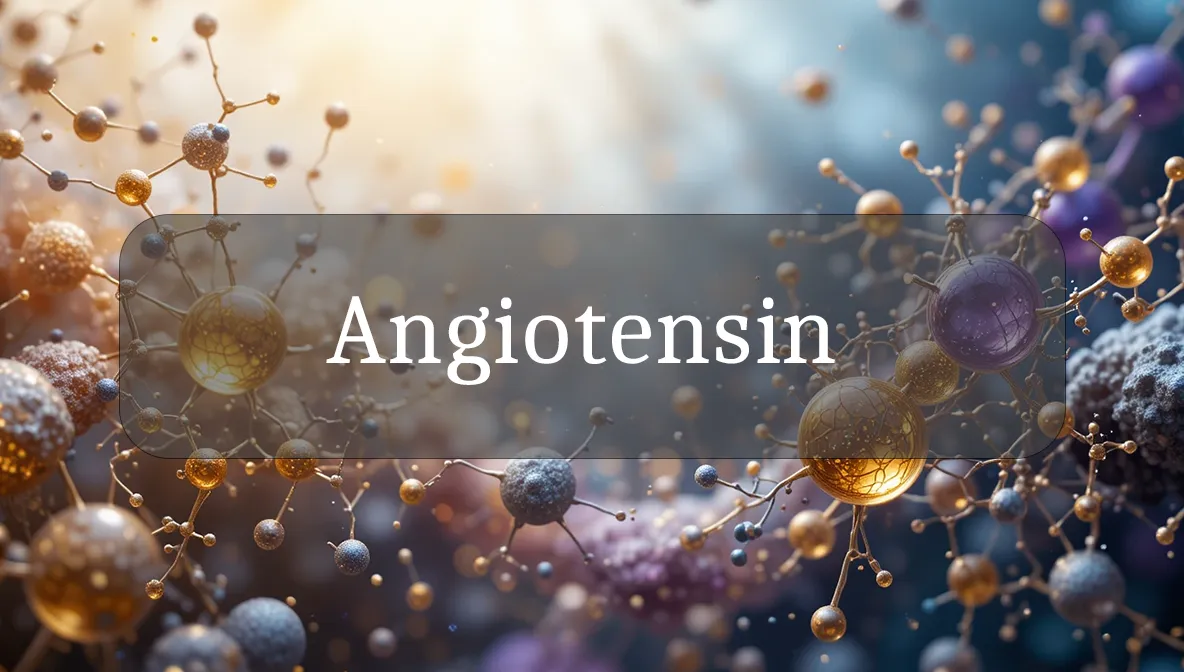Body’s Blood Pressure Regulator
Angiotensin is like a master switch in your body, helping control blood pressure and fluid balance to keep your heart, kidneys, and blood vessels working smoothly. This powerful molecule plays a key role in your cardiovascular system, but too much or too little can cause health issues. In this article, we’ll break down what angiotensin is, how it supports your wellness, and practical ways to keep it balanced, all in a friendly, easy-to-read way for health-conscious readers.
Chemical Identity and Type
Angiotensin is a molecule, specifically a peptide hormone (a small protein-like signal) that comes in several forms, with angiotensin II being the most active. It’s part of the renin-angiotensin-aldosterone system (RAAS), a chain reaction in your body that regulates blood pressure, fluid balance, and electrolyte levels. Angiotensin starts as an inactive protein (angiotensinogen) made by the liver, which is then converted into angiotensin I and finally angiotensin II by enzymes like ACE (angiotensin-converting enzyme). Think of angiotensin II as a body signal that tells your blood vessels to tighten and your kidneys to hold onto water and salt.
Biological Role and Benefits
Angiotensin, particularly angiotensin II, is vital for maintaining your body’s balance and offers several health benefits when properly regulated:
- Regulates Blood Pressure: Angiotensin II narrows blood vessels (vasoconstriction), raising blood pressure to ensure your organs get enough blood, especially during stress or low fluid levels.
- Maintains Fluid Balance: It signals your kidneys to retain water and sodium, helping prevent dehydration and keeping blood volume stable.
- Supports Heart and Kidney Function: By controlling blood pressure, angiotensin helps your heart pump effectively and your kidneys filter blood properly.
- Responds to Stress: During situations like blood loss or intense exercise, angiotensin helps your body adapt by stabilizing circulation.
When balanced, angiotensin keeps your cardiovascular system running smoothly, supporting energy and vitality.
Dietary or Natural Sources
Your body produces angiotensin naturally, starting with angiotensinogen in the liver, so it’s not found in foods or supplements. However, you can support healthy angiotensin function with nutrients and foods that promote cardiovascular health:
- Potassium-Rich Foods: Bananas, oranges, spinach, and sweet potatoes help balance sodium levels, reducing strain on the RAAS.
- Magnesium-Rich Foods: Nuts, seeds, and leafy greens support blood vessel health and blood pressure regulation.
- Low-Sodium Foods: Whole foods like fresh vegetables, fruits, and lean proteins help prevent overactivation of angiotensin II.
- Omega-3 Fatty Acids: Found in salmon, walnuts, and flaxseeds, these support heart health and reduce inflammation, complementing angiotensin’s role.
A balanced diet helps keep the RAAS and angiotensin levels in check.
Signs of Imbalance or Dysfunction
Too much or too little angiotensin activity can disrupt your health, leading to noticeable symptoms:
- High Angiotensin (Overactive RAAS):
- High Blood Pressure (Hypertension): Persistent high readings (e.g., above 130/80 mmHg), causing headaches, dizziness, or chest pain.
- Fluid Retention: Swelling in the legs, ankles, or face due to excessive water and sodium retention.
- Heart Strain: Fatigue, shortness of breath, or irregular heartbeat from overworked blood vessels.
- Low Angiotensin (Underactive RAAS):
- Low Blood Pressure: Dizziness, fainting, or fatigue, especially when standing up quickly.
- Dehydration: Thirst, dry mouth, or dark urine due to poor fluid retention.
- Kidney Issues: Reduced urine output or electrolyte imbalances.
If you notice these symptoms, a doctor may check blood pressure, kidney function, or electrolyte levels to assess RAAS activity.
Supporting Optimal Levels or Function
To keep angiotensin and the RAAS balanced for healthy blood pressure and fluid regulation, try these practical wellness tips:
- Eat a Heart-Healthy Diet: Focus on potassium- and magnesium-rich foods (like avocados and beans) and limit processed foods high in sodium (like chips or canned soups).
- Stay Active: Moderate exercise, like 30 minutes of walking, cycling, or yoga most days, supports healthy blood pressure and RAAS function.
- Manage Stress: Chronic stress can overactivate angiotensin II, so practice relaxation techniques like deep breathing or meditation.
- Stay Hydrated: Drink water regularly (about 8 cups daily, adjusted for activity) to support fluid balance and kidney health.
- Limit Alcohol and Avoid Smoking: These can raise blood pressure and strain the RAAS, so keep them minimal.
Safety, Interactions, and Precautions
Since angiotensin is produced by your body, it’s not supplemented, but certain factors can affect its balance:
- Overactivity Risks: Excessive angiotensin II is linked to hypertension, heart failure, or kidney disease, often requiring medical management.
- Medications: Drugs like ACE inhibitors (e.g., lisinopril) or ARBs (e.g., losartan) block angiotensin II to lower blood pressure but may cause side effects like dizziness or low potassium. Use only under medical supervision.
- Chronic Conditions: Diabetes, obesity, or kidney disease can disrupt RAAS balance, increasing angiotensin activity and health risks.
- Interactions: High-potassium foods or supplements may interact with RAAS-targeting medications, so check with a doctor if you’re on these drugs.
- Lifestyle Stressors: High sodium intake, chronic stress, or dehydration can overstimulate angiotensin, raising blood pressure.
Fun Fact
Angiotensin was discovered in the 1930s when scientists noticed a substance in the blood that could dramatically raise blood pressure. Its name comes from “angio” (vessel) and “tensin” (tension), perfectly describing its role in tightening blood vessels to keep your circulation strong!
Citations
- National Institutes of Health. (n.d.). Renin-Angiotensin-Aldosterone System and Blood Pressure.
- Mayo Clinic. (2023). High Blood Pressure and the RAAS.
- Cleveland Clinic. (2024). Angiotensin and Cardiovascular Health.
- World Health Organization. (2022). Hypertension and Cardiovascular Disease.
- StatPearls – NCBI Bookshelf. (2023). Renin-Angiotensin System in Health and Disease.

